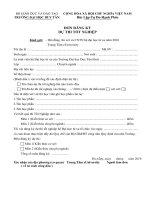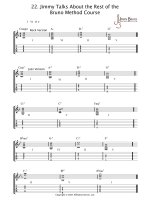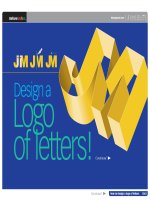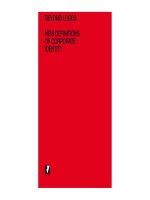Overview of indicator organisms tủ tài liệu bách khoa
Bạn đang xem bản rút gọn của tài liệu. Xem và tải ngay bản đầy đủ của tài liệu tại đây (1.7 MB, 42 trang )
Overview of
Indicator Organisms
“indicators” of fecal
contamination
|
Non-pathogenic organisms that can
indicate the presence of pathogens
z
Bacteria
•
•
•
•
•
z
Total coliforms
Fecal coliforms
Escherichia coli
Enterococci
Clostridium perfringens
Viruses
• coliphage
Why not test directly for
waterborne pathogens?
|
Safety
z
|
Time and cost
z
|
May require cultivation and direct
manipulation of pathogenic organisms
Each pathogen must be detected using a
different test
Requires processing of large volumes of
sample
z
Pathogens usually are present in low
concentrations
Advantage of “Indicators”
|
Indicator organisms
z
z
|
NOT pathogenic
Used to directly detect the presence of fecal
contamination from warm-blooded animals
which "indicates" the possible presence of
pathogenic organisms
Indicator chemicals
z
z
Used to indirectly indicate the presence of
fecal contamination from humans or animals
caffeine, coprostanol, fragrances and other
human-associated chemicals
An Ideal Indicator Organism
|
|
|
|
|
|
Has an easy testing procedure
Is of human or animal origin
Survives as long as, or longer, than
pathogens
Present at densities related to the severity
of fecal contamination
Is a "surrogate" for many different
pathogens
Useful in fresh and saline waters
Weaknesses of Indicator
Organisms
|
May be present when there is no fecal
contamination
z
|
Absent when pathogens are present
z
|
Total coliforms and C. perfringens are found in soil
so they are poor indicators of fecal contamination
E. coli may die off faster than viral pathogens
Density may not always relate well to the density
of pathogens
z
E. coli can reproduce in warm, tropical waters.
BACTERIAL INDICATORS
E. coli cells (from USEPA web site)
Common Indicator Bacteria
|
Coliform group
z
z
z
|
Streptococci
z
z
|
total coliforms
fecal coliforms
Escherichia coli
Enterococci
fecal streptococci
Spore formers
z
Clostridium perfringens
The Coliform Group of Bacteria
Enterobacteriaceae
Total coliforms
Fecal coliforms
E. coli
Coliform Characteristics
Coliforms are facultative anaerobic, gram-negative, nonspore forming, and able to ferment lactose
|
Total coliforms
z
z
|
Fecal coliforms
z
z
|
Ubiquitous in the environment; because they include fecal
coliforms and E. coli they may indicate fecal contamination
Ferment lactose at 35 °C
May be of fecal origin
Ferment lactose at 44.5 °C
Escherichia coli
z
z
Inhabits gastrointestinal tract of warm-blooded animals so is a
specific indicator of fecal pollution
Ferment lactose at 44.5 °C, do not produce urease, and
produce β-D-glucuronidase
Most Appropriate
Applications
|
Total coliforms
z
|
Fecal coliform
z
|
Ground-water drinking-water supply
Fresh surface water to meet a specific
State’s regulatory requirement
E. coli
z
z
Fresh surface waters
Ground water that has tested positive for
total coliform
Analytical Techniques for
Indicator Bacteria
|
|
|
Membrane filter and direct
plating
z Grow on a filter
membrane
z Report in colony forming
units (CFU)
Multiple Tube
z Grow in liquid medium
z Report in Most-Probable
Number (MPN)
z Example: Colilert®
Presence-Absence
z Example: Colilsure®
Detection and Enumeration
Methods: Coliforms
|
Total coliform
z
z
z
z
z
z
z
|
mENDO
MI
Colilert® quantitray
Colitag™ P/A
Coliscan®
Coliblue®
Colisure®
Fecal coliform
z
mFC
|
E. coli
z
z
z
z
z
z
z
z
z
mENDO/NA-MUG
MI
mTEC
Modified mTEC
Colilert® quantitray
Colitag™ P/A
Coliscan®
Coliblue®
Colisure®
Total coliforms and E. coli:
MI Medium
|
|
Under ambient
light, E. coli
colonies are blue
The same plate
under UV light;
total coliform
colonies fluoresce
E. coli: modified mTEC
modified mTEC
E. coli are magenta
Total coliforms and E. coli:
Colilert Quantitray
|
|
Under ambient
light, total coliform
colonies are yellow
The same tray
under UV light;
total coliform
colonies that are E.
coli fluoresce
Fecal Coliforms: mFC
medium
|
Fecal coliforms
are blue or
grayish blue
Common Bacteria Indicators
|
Coliform group
z
z
z
|
Streptococci
z
z
|
total coliforms
fecal coliforms
Escherichia coli
Enterococci
fecal streptococci
Spore formers
z
Clostridium perfringens
Streptococcus Group of Bacteria
Streptococci
Group D
(includes fecal streptococci)
Enterococci
E. faecalis Group Q
E. faecium S. avium
S. galinarum
Fecal Streptococci
Characteristics
|
Fecal streptococci
z
z
|
Ubiquitous in the environment but
may be of fecal origin thus a poor fecal
indicator
Gram positive cocci; grow at 35 °C
Enterococci
z
z
z
Good indicator of fecal contamination
although some strains are ubiquitous
Grows in 6.5% NaCl; EPA recommends
use for marine waters
Gram positive cocci; grow at 41.5 °C
Detection and Enumeration
Methods: Enterococci
|
Enterococci
z
z
z
mE/EIA
mEI
Enterolert™
Enterococci: mEI Medium
|
Colonies with blue
halos are counted
as enterococci,
regardless of
colony color
Enterococci: Defined Substrate
Technology
|
|
Enterococci produce
Blue fluorescence
under UV light
Marine samples
must be diluted to
reduce false
positives
Common Bacteria Indicators
|
Coliform group
z
z
z
|
total coliforms
fecal coliforms
Escherichia coli
Streptococci
z
z
|
C. perfringens
Enterococci
fecal streptococci
Spore formers
z
Clostridium perfringens
CDC public health image library C. botulinum
Processing samples
Membrane filtration
Defined substrate technology









